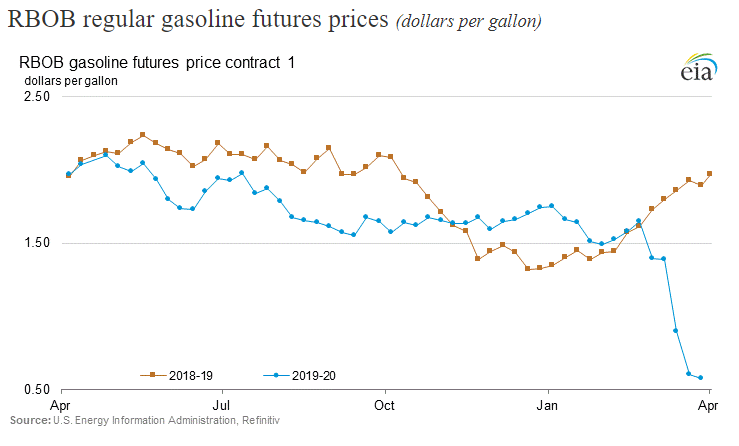1/Ok, time for another Wonky Thoughts About What the Oil Price Crash Means for the Clean Energy Transitionᵀᴹ, this time with a focus on gasoline demand, refining, and what it can teach us about EV adoption. THREAD
2/Shelter-in-place means people aren’t driving as much. That predictably has made gasoline demand drop like a rock, which has made prices drop like a rock too. Check out RBOB gas futures, down 70% (!!) y/y.
3/But here’s the interesting part: gasoline and diesel are moving in different directions. The “crack spread”, basically the profit a refiner makes on the product, was ~$20/bbl for BOTH gasoline and diesel at the beginning of the year.
4/Though both were ~$20 in Jan, now the gasoline crack spread (RBOB) has plummeted, even going below $0/bbl for a bit, while the diesel crack spread has stayed relatively strong, still now ~$15/bbl. So what’s going on?
5/Refiners are cutting back. EIA tracks refinery utilization, and it fell to 82% this week, down from 87% just a week ago. This is in response to the sharp drop in gasoline demand, but it impacts ALL petroleum products.
6/Gasoline makes up about half of what refiners make so it often drives the decisions. But cutting back on refining also impacts other products like distillates (25%), jet fuel (9%) and others.
7/So while refining is cut in response to gasoline demand, it also means supply of other products get cut too. This becomes really important for distillates, which have much more diverse uses than motor gasoline.
8/Distillates include diesel that fuels equipment, trucks, buses, boats, etc. as well as generators, and also heating oil for home and commercial use. Because it’s far more diverse, it’s demand has been far more robust during the current crisis.
9/What’s played out in the last couple of weeks will be exactly what plays out over the next decade as EV adoption ramps up. EVs sales are set to skyrocket, and that will lead to significant demand destruction of gasoline.
10/But interestingly for non-gasoline petroleum products, like jet fuel, diesel for trucking, shipping, heavy equipment, and fuel oil, clean technologies are not as readily available as EVs are for light-duty transportation.
11/This means EV-driven demand destruction will hit gasoline first, before distillates and other projects, which will look a lot like what has happened in the last couple of weeks. A couple of takeaways:
12/Demand hitting gasoline will drive gas cracks lower. If there is still value in distillates, jet fuel, and chem, refiners may keep producing gas even at negative margins. This means gasoline prices may be even lower than forecast and hurt EV adoption.
13/Tech solutions for air, shipping, and trucking must be developed concurrently to EVs otherwise the refining dynamic will drive gas cracks so low it will hurt EV adoption. It’s not a tomorrow problem, solutions are needed now for decarbonization.
14/On the refining side, refiners who produce disproportionately lower gasoline vs. distillates, jet fuel, and chems will outperform relative to gasoline heavy refiners in the early parts of the clean energy transition.
15/SUMMARY: Current demand destruction of gasoline provides an interesting crystal ball into the future of transportation. Lessons abound on gasoline prices, EV adoption, and the need for solutions to air, shipping, and trucking. END

 Read on Twitter
Read on Twitter







